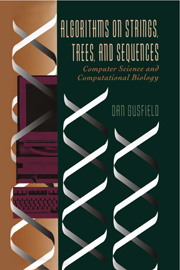Book contents
- Frontmatter
- Contents
- Preface
- I Exact String Matching: The Fundamental String Problem
- II Suffix Trees and Their Uses
- 5 Introduction to Suffix Trees
- 6 Linear-Time Construction of Suffix Trees
- 7 First Applications of Suffix Trees
- 8 Constant-Time Lowest Common Ancestor Retrieval
- 9 More Applications of Suffix Trees
- III Inexact Matching, Sequence Alignment, Dynamic Programming
- IV Currents, Cousins, and Cameos
- Epilogue – where next?
- Bibliography
- Glossary
- Index
7 - First Applications of Suffix Trees
from II - Suffix Trees and Their Uses
Published online by Cambridge University Press: 23 June 2010
- Frontmatter
- Contents
- Preface
- I Exact String Matching: The Fundamental String Problem
- II Suffix Trees and Their Uses
- 5 Introduction to Suffix Trees
- 6 Linear-Time Construction of Suffix Trees
- 7 First Applications of Suffix Trees
- 8 Constant-Time Lowest Common Ancestor Retrieval
- 9 More Applications of Suffix Trees
- III Inexact Matching, Sequence Alignment, Dynamic Programming
- IV Currents, Cousins, and Cameos
- Epilogue – where next?
- Bibliography
- Glossary
- Index
Summary
We will see many applications of suffix trees throughout the book. Most of these applications allow surprisingly efficient, linear-time solutions to complex string problems. Some of the most impressive applications need an additional tool, the constant-time lowest common ancestor algorithm, and so are deferred until that algorithm has been discussed (in Chapter 8). Other applications arise in the context of specific problems that will be discussed in detail later. But there are many applications we can now discuss that illustrate the power and utility of suffix trees. In this chapter and in the exercises at its end, several of these applications will be explored.
Perhaps the best way to appreciate the power of suffix trees is for the reader to spend some time trying to solve the problems discussed below, without using suffix trees. Without this effort or without some historical perspective, the availability of suffix trees may make certain of the problems appear trivial, even though linear-time algorithms for those problems were unknown before the advent of suffix trees. The longest common substring problem discussed in Section 7.4 is one clear example, where Knuth had conjectured that a linear-time algorithm would not be possible [24, 278], but where such an algorithm is immediate with the use of suffix trees. Another classic example is the longest prefix repeat problem discussed in the exercises, where a linear-time solution using suffix trees is easy, but where the best prior method ran in O(n log n) time.
Information
- Type
- Chapter
- Information
- Algorithms on Strings, Trees, and SequencesComputer Science and Computational Biology, pp. 122 - 180Publisher: Cambridge University PressPrint publication year: 1997
Accessibility standard: Unknown
Why this information is here
This section outlines the accessibility features of this content - including support for screen readers, full keyboard navigation and high-contrast display options. This may not be relevant for you.Accessibility Information
- 1
- Cited by
